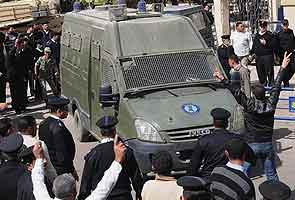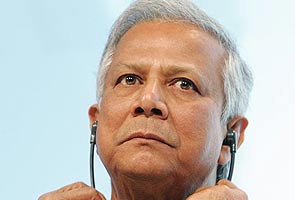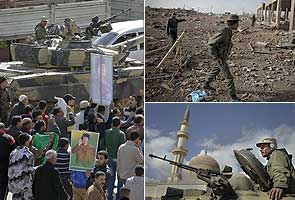Tripoli: Government forces in tanks rolled into the opposition-held city closest to Tripoli after blasting it with artillery and mortar fire, while rebels captured a key oil port and pushed toward Muammar Gaddafi's hometown in a seesaw Saturday for both sides in the bloody battle for control of Libya.
With the Gaddafi regime's tanks prowling the centre of the city of Zawiya, west of Tripoli, residents ferried the wounded from the fierce fighting in private cars to a makeshift clinic in a mosque, fearing that any injured taken to the military-controlled hospital "will be killed for sure," one rebel said after nightfall.
The rival successes - by Gaddafi's forces in entering resistant Zawiya, and by the rebels in taking over the port of Ras Lanouf - signalled an increasingly long and violent battle that could last weeks or months and veered the country ever closer to civil war.
Rebels in the east advanced from their eastern stronghold toward Sirte, setting the stage for fierce fighting with pro-Gaddafi forces that hold sway in the tribal area.
Western leaders focused on humanitarian aid instead of military intervention, and the Italian naval vessel Libra left from Catania, Sicily, for the rebel-held port of Benghazi in eastern Libya, with 25 tons of emergency aid, including milk, rice, blankets, emergency generators, water purifying devices and tents. It is due to arrive early Monday.
The crisis in Libya has distinguished itself from the other uprisings sweeping the Arab world, with Gaddafi unleashing a violent crackdown against his political opponents, who themselves have taken up arms in their attempt to remove him from office after ruling the country for more than 41 years. Hundreds have been killed.
Gaddafi has drawn international condemnation for his actions. President Barack Obama has insisted that Gaddafi must leave and said Washington was considering a full range of options, including the imposition of a "no-fly" zone over Libya.
The storming of Zawiya, a city of some 200,000 people just 30 miles (50 kilometres) west of Tripoli, began with a surprise dawn attack by pro-Gaddafi forces firing mortar shells and machine guns.
"The number of people killed is so big. The number of the wounded is so big. The number of tanks that entered the city is big," the rebel in Zawiya said, speaking on condition of anonymity because he feared government reprisal. The rebels vowed to keep up the fight in the city.
Witnesses who spoke to The Associated Press by telephone with gunfire and explosions in the background said the shelling damaged government buildings and homes. Several fires sent heavy black smoke over the city, and witnesses said snipers shot at anybody on the streets, including residents on balconies.
The rebels initially retreated to positions deeper in the city before they launched a counteroffensive in which they regained some ground, according to three residents and activists who spoke on condition of anonymity for fear of reprisals.
By mid- afternoon, the rebels had reoccupied central Martyrs' Square while the pro-regime forces regrouped on the city's fringes, sealing off the city's entry and exit routes, the witnesses said. Members of the elite Khamis Brigade named for one of Gaddafi's sons who command it, have been massed outside the city for days.
The pro-Gaddafi forces then blasted Zawiya with artillery and mortar fire in late afternoon before the tanks and troops on foot came in, firing at buildings and people, witnesses said.
Deputy Foreign Minister Khaled Qaid said "99 per cent" of Zawiya is under government control.
"The situation in Zawiya is quiet and peaceful right now," he said Saturday at a news conference. "We hope by tomorrow morning, life will be back to normal."
The rebels fared better in the east, capturing the key oil port of Ras Lanouf on Friday night in their first military victory in a potentially long and arduous westward march from the east of the country to Gaddafi's eastern stronghold of Tripoli.
Witnesses said Ras Lanouf, about 90 miles (140 kilometres) east of Sirte, fell to rebel hands on Friday night after a fierce battle with pro-regime forces who later fled.
"Go to Tripoli!" one of the fighters yelled in English.
Another brandished a bayonet, pointed to its blade and said: "I need head Gaddafi! Head Gaddafi I need!"
An Associated Press reporter who arrived in Ras Lanouf Saturday morning saw Libya's red, black and green pre-Gaddafi monarchy flag, which has been adopted by the rebels, hoisted over the town's oil facilities.
One of the rebels, Ahmed al-Zawi, said the battle was won after Ras Lanouf residents joined the rebels.
Al-Zawi, who participated in the fighting, said 12 rebels were killed in the fighting, in which rocket-propelled grenades and anti-aircraft guns were used.
Officials at a hospital in the nearby city of Ajdabiya, however, said only five rebels were killed and 31 wounded in the attack. The discrepancy in the figures could not immediately be explained.
"They just follow orders. After a little bit of fighting, they run away," said another rebel at Ras Lanouf, Borawi Saleh, an 11-year veteran of the army who is now an oil company employee.
A witness in Ajdabiya said rebels had begun their push toward Sirte, reaching the town of Nawfaliyah, 50 miles (80 kilometres) from Ras Lanouf. The witness said he was going to join them and expected fierce fighting with pro-Gaddafi forces.
Also Saturday, witnesses said a Libyan jet fighter crashed near Ras Lanouf. They were displaying pictures showing the pilot's body and twisted wreckage from the plane. The cause of Saturday's crash couldn't immediately be determined.
Pro-Gaddafi forces have launched a number of airstrikes against rebel targets as they seek to put down the 19-day-old rebellion.
In Benghazi, Libya's second-largest city, funerals were held for some of the 26 people killed in an explosion Friday at a large arms and ammunition depot outside town. The massive blast levelled flattened buildings, cars and trees in an area three times the size of a soccer field.
It also deprived the rebels of arms and ammunition. It was not immediately clear how the depot blew up, but suspicion immediately fell on Gaddafi agents.
Hundreds lined the streets to pay their respects to the dead before starting chants against Gaddafi.




 Paris: Mankind may have unleashed the sixth known mass extinction in Earth's history, according to a paper released by the science journal Nature.
Paris: Mankind may have unleashed the sixth known mass extinction in Earth's history, according to a paper released by the science journal Nature. 









